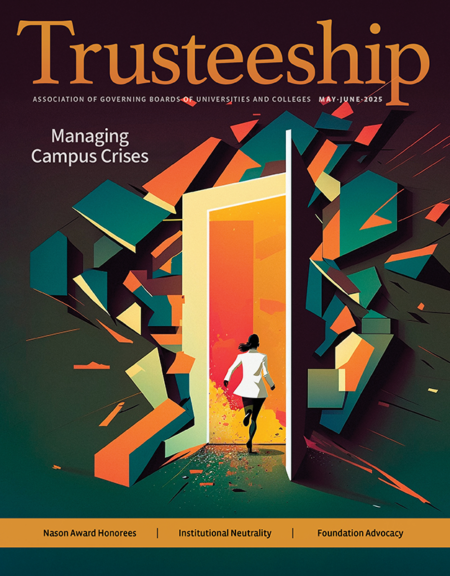
Sara Goldrick-Rab, PhD, is a sociologist who founded the #RealCollege movement to support students’ basic needs. She is the author of the award-winning book Paying the Price: College Costs, Financial Aid, and the Betrayal of the American Dream, the founder of two national organizations, a frequent advisor to higher education leaders and policymakers, and a passionate teacher at the Community College of Philadelphia. Goldrick-Rab spoke at the 2025 National Conference on Trusteeship.
Why is it important for boards to realize that “meeting students where they are” is critical to institutional success?
Understanding students is central business intelligence. Students’ enrollment decisions and their college financing decisions drive revenue and cash flow. When board members’ personal backgrounds diverge from those of their students, they risk being less effective, unless they take steps to bridge those gaps. Most of today’s students do not have the luxury of focusing exclusively on school without also attending to the demands of family, employers, and their own health, and well-being. Thus, their decisions are increasingly affected by the basic challenges all adults face—life, logistics, and money. Advancing fiscal sustainability of an institution requires ensuring that students’ needs for support inform institutional strategy and resource prioritization. Data that help boards accurately ground their understandings of the students they have, rather than those they might wish they have, is foundational to their success. In my own work, I’ve seen institutions become far more attuned by learning even a few new things, like how many of their students don’t have enough to eat or are raising children.
With so many challenges facing higher education, how can boards better prioritize the needs of their most vulnerable students?
I encourage college leaders to start with curiosity and ask better questions. Seek information about how students are really experiencing your institution and pay close attention to the experiences of people who are not currently engaging with or succeeding there. Find out what barriers they face and how their resilience shapes the way they engage. They are often best positioned to highlight problems, offer valuable feedback, and reveal opportunities for building trust, which are critical to students’ sense of belonging and loyalty to the institution.
With those data in mind, consider how the president and their counterparts talk about students, and how they engage students in the institution’s decision-making. What systematic policies or procedures are in place to address students’ human needs, promote their health, and undergird their financial well-being so they can focus on academics? How are faculty trained and supported to educate adults navigating complex lives while trying to learn? Is there an institutional culture of care? What real-time metrics are used to monitor improvements to students’ experiences and make changes as needed?
Do you see an opportunity for institutions to reframe their responses to the current challenges in higher education? If so, what strategies might prove most effective?
Absolutely. The current moment is an opportunity to remind the public that college students are regular people they know and love, people working beside them, attending church with them, and raising families as their neighbors. They attend college not to demonstrate a sense of superiority or get ahead of other people but to improve their lives and the lives of people they care about. Colleges and universities exist to serve their needs—not the other way around. Boards should tell the stories of budgetary and related cuts in human terms, dispelling myths, and revealing the truth: higher education is part of the social fabric and its unraveling hurts everyone. And while telling those stories, boards should stay focused on the horizon and make sure they are demanding that their institutions become ever more student- and community-serving.
–interview by Erin Geraghty, Trusteeship managing editor
RELATED RESOURCES

Tools and Toolkits
Board Responsibility for Equitable Student Success



